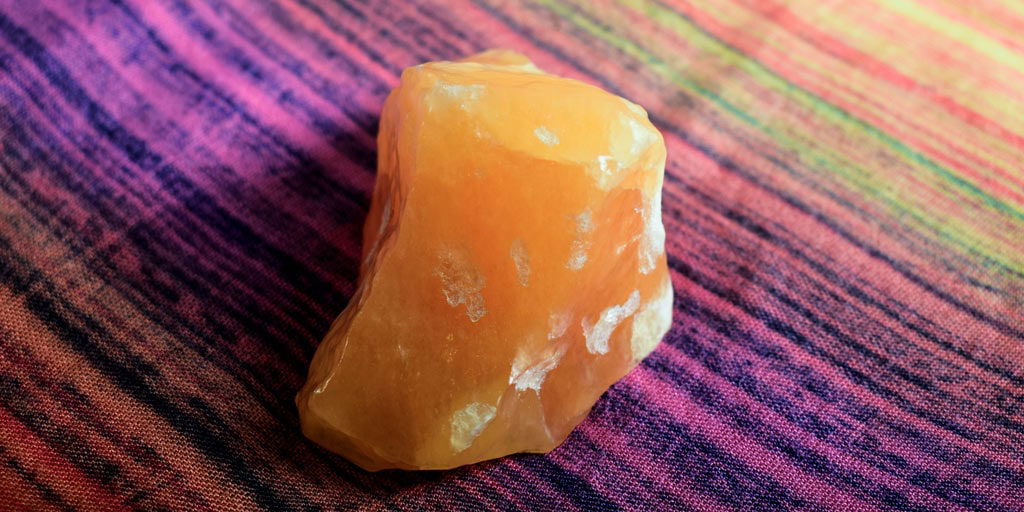
Can you cleanse orange calcite in water? Or will it dissolve or crack? Keep reading to find out whether orange calcite can get wet.
Can Orange Calcite Go in Water?
Orange calcite should not be left in water for a long period of time. It’s a carbonate mineral that won’t dissolve, but the stone’s softness means it will suffer from gradual damage the longer it’s in water.
Why Orange Calcite is Not Water Safe
Some crystals are impervious to water and can be left submerged for long periods without damage. Other crystals are soft and will dissolve if they get even slightly wet.
Orange calcite doesn’t fall into either of these groups. It’s a soft crystal that only registers as a three on the Mohs Scale of Crystal Hardness, but it won’t be damaged by a splash of water.
As it’s a carbonate mineral, it’s also stable in water and won’t dissolve like some other soft crystals.
With that said, orange calcite softness means it shouldn’t be left underwater for long periods. Over time, water can damage the structure of the calcite, leading to cracks and weakening.
What is the Mohs Hardness Scale?
The Mohs Hardness Scale is a rating out of ten for a crystal’s hardness. Diamond is the hardest, so it has a rating of ten, while talc is the softest with a rating of one.
The general rule is that crystals with a Mohs rating of less than six are not safe to spend a long time in water. This rule isn’t true for every crystal – some harder crystals have inclusions that may rust in water, for example – but it’s still a useful guide.
What Happens if Orange Calcite Gets Wet?
As I mentioned earlier, a splash of water is very unlikely to damage an orange calcite crystal. So, don’t panic if your stone accidentally gets wet!
Orange calcite can be damaged by spending a long time in water though.
Water (or other liquids) can seep into microscopic cracks on the surface of an orange calcite crystal. Over time, the water causes these cracks to open and become wider – particularly as calcite is soft.
This causes the stone to look dull, scratched, and may even lead to visible cracks. That’s why I don’t recommend using water to cleanse orange calcite.
Tip: A common mistake is to assume that a crystal is water safe after testing it in a bath for a few hours. Many of the effects of water take a long time to become obvious, but once they occur they are irreversible.
What About Salt Water?
Salt water is more corrosive than regular water, so it’s more damaging to orange calcite. You shouldn’t use salt water to cleanse or clean your orange calcite crystal – even for short periods of time.
How to Cleanse Orange Calcite
While placing orange calcite in running water for a brief cleanse probably won’t damage it, there are plenty of other methods that avoid any risk of water damage.
Some examples include:
- You can use a larger crystal to cleanse an orange calcite stone. This is a relatively slow method that takes up to 24 hours, but is one of the easiest ways to cleanse negative energy. Amethyst geodes are a popular choice for cleansing, but be gentle as orange calcite is much softer than amethyst.
- Leaving a crystal in moonlight throughout the night is one of the gentlest ways to cleanse an orange calcite stone. Make sure the stone is covered by a glass bowl if there’s a chance of rain.
- An alternative method for cleansing orange calcite is smudging. Hold the crystal in the smoke of a smouldering bundle of dried sage (in a fire proof container) to remove negativity.
- You can also use selenite to cleanse and charge a healing crystal. I enjoy using a selenite plate to charge orange calcite, as this allows for plenty of physical contact between the two crystals.
To learn more, read my guide to how to cleanse orange calcite.
What About Cleansing Orange Calcite With Sunlight?
Some people use sunlight for cleansing orange calcite. While this is an effective method that also charges the crystal, too much direct sunlight can cause calcite to become brittle.
For this reason, be careful when using sunlight to cleanse orange calcite and avoid using this method too frequently.
Frequently Asked Questions
Can Orange Calcite Be Used in a Crystal Elixir?
As orange calcite is a soft stone that can be damaged over time by water, you shouldn’t use it in a crystal elixir. Tiny particles from the stone could end up in the water, which may make it dangerous to drink.
Instead, you can use the indirect method to charge water using orange calcite.
After cleansing, put the orange calcite inside a sealed glass jar, then place the jar in a larger bowl of water. Leave the crystal to infuse the water, making sure that the stone never directly touches the liquid.
Can Orange Calcite Go in Moon Water?
Moon water has been infused by the light of a full moon. While moon water has many uses in crystal healing, it can still damage orange calcite if the stone is submersed.
Are Other Types of Calcite Water Safe?
No, all types of calcite have the same hardness, so they are susceptible to water damage if submersed for long periods.
Where is Orange Calcite Found?
As a form of calcite, which is a very common crystal, orange calcite is found around the world. The biggest deposits are thought to be in South America and Mexico.
Summary
Orange calcite shouldn’t be left in water for long periods of time. It’s a soft crystal, so microscopic cracks on the surface may become larger over time if the stone is submersed.
The good news is that orange calcite isn’t a stone that dissolves in water. As it’s a carbonate mineral, it’s stable in water, so small splashes or brief water cleanses probably won’t damage it.
I still recommend avoiding using water to clean or cleanse orange calcite though. It’s a beautiful crystal that provides many healing properties, so I never want to risk causing damage to its appearance or structure.
Do you have any questions about whether orange calcite can get wet? Please let me know in the comments section below.
